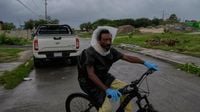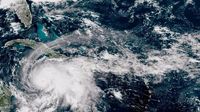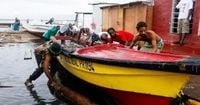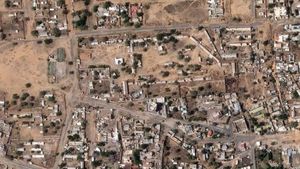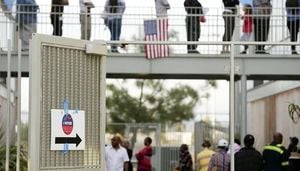As Hurricane Melissa bore down on Jamaica late Monday, October 27, 2025, residents and visitors alike braced for what forecasters warned could be the most powerful storm ever recorded to strike the island. The Category 5 hurricane, with sustained winds of 175 mph (282 km/h), was poised to make landfall early Tuesday near St Elizabeth Parish in southern Jamaica, before continuing its destructive path northward and exiting near St Ann Parish. The United States National Hurricane Center (NHC) described the approaching storm as a "catastrophic" threat, with the potential for life-threatening winds, torrential rainfall, and a storm surge of up to 13 feet (4 meters) along Jamaica's southern coast.
According to ABC News, Americans in Jamaica spent Monday night and Tuesday morning preparing for the worst. Carmencita Kay Williams Wilson, a Houston resident staying at Pineapple Beach in St James' Parish, shared her anxious preparations: "We've cleared out the patio and the chairs, put tape on the window as much as we can. It's just now starting to drizzle and rain on this part of the island... So we're holding on in there." Tampa resident Kate Nguyen, staying at a Montego Bay hotel, described a restless night: "I got a little sleep, but I was too anxious and worried, not just for myself but for people in the area." Maritza Caver-Blake and her husband, visiting from Arkansas for their tenth anniversary, found themselves stranded and unable to return home to their young children. "We’ve been praying a lot. They were expecting their parents back on Sunday. We don’t want to tell them, ‘Mommy and daddy are stuck in another country.’"
Jamaican Prime Minister Andrew Holness echoed the anxiety felt across the island, telling citizens, "I urge all Jamaicans to stay inside and remain within the safety of your homes. Avoid unnecessary travel. Strong winds, heavy rains and flash floods can occur at any moment." He added, "There is no infrastructure in the region that can withstand a Category 5. The question now is the speed of recovery. That’s the challenge." Holness also expressed his concern for maintaining order, assuring the public that security forces were deployed to protect communities during the disaster.
The government responded with sweeping measures to mitigate the storm’s impact. As reported by the Associated Press, mandatory evacuations were ordered in flood-prone areas, with buses ferrying residents to over 880 shelters established across the island. Yet, despite official pleas, many Jamaicans hesitated to leave their homes. Daryl Vaz, Jamaica’s transport minister, voiced frustration: "It’s way, way below what is required for a Category 5 hurricane... If you are not [smart], unfortunately, you will pay the consequences." Some, like 64-year-old fisherman Noel Francis in Old Harbor Bay, simply refused to evacuate, saying, "I hear what they say, but I am not leaving. I can manage myself." Others, such as Hyacinth White, cited concerns about flooding but still chose to stay put.
For those who did seek shelter, conditions varied. In Montego Bay, guests like Kate Nguyen slept on camp beds, while in the farming community of St Elizabeth, store owner Enrico Coke opened his doors to neighbors. "I’m concerned about farmers. The fishermen will be suffering after this. We’ll need help as soon as possible, especially water for the people," Coke told AFP. The reluctance to use government shelters was often rooted in past experiences. Sandra Walker, a single mother and street vendor in Black River, recalled a "terrible" shelter experience during Hurricane Ivan, where food supplies were woefully inadequate.
By late Monday, the storm’s effects were already being felt. Power outages affected more than 50,000 customers, and reports of landslides, fallen trees, and downed power lines mounted. The NHC warned that up to 30 inches (76 centimeters) of rain could fall in eastern Jamaica, raising the risk of catastrophic flash flooding and landslides. The slow pace of Hurricane Melissa—moving northwest at just 2 mph (4 kph)—meant that punishing conditions would linger for hours, compounding the danger and potential for damage.
The toll from Melissa had already begun to mount across the Caribbean. Seven deaths were attributed to the storm: three in Jamaica (two from tree-cutting accidents and one electrocution), three in Haiti, and one in the Dominican Republic, where another person remained missing. In Haiti, the storm destroyed crops in three regions, including 37 acres of maize, exacerbating a hunger crisis affecting more than half the population. The Dominican Republic saw more than 750 homes damaged and over 3,700 people displaced, with floodwaters cutting off access to at least 48 communities.
As the hurricane approached, Jamaican officials stressed that they had done all they could to prepare. Desmond McKenzie, Minister of Local Government and Community Development, told Al Jazeera, "We have put everything in place in regards to what are required in terms of evacuation, getting people to our shelters, providing the requisite resources, … and we have been cleaning our drains. We have been cleaning our gulleys." He noted that while shelter occupancy was uneven, demand was rising in certain parishes.
After Jamaica, Melissa was forecast to cross over eastern Cuba on Tuesday night, with hurricane warnings issued for Granma, Santiago de Cuba, Guantanamo, and Holguin provinces. Cuban officials began evacuating more than 600,000 people, including residents of Santiago, the island’s second-largest city. Bus lines stretched long as families sought safety. The Bahamas and Turks and Caicos Islands were also placed under hurricane and tropical storm warnings, respectively, as the storm’s path threatened to bring further destruction.
Experts pointed to climate change as a factor in Melissa’s rapid intensification. Meteorologist Kerry Emanuel explained to AFP that global warming is causing more storms to strengthen quickly, increasing the risk of devastating rainfall. "Water kills a lot more people than wind," he noted. Climate scientist Daniel Gilford added, "Human-caused climate change is making all of the worst aspects of Hurricane Melissa even worse." The storm’s slow movement and sheer intensity, he said, were hallmarks of a changing climate.
Melissa stands out in Jamaica’s hurricane history. As noted by Evan Thompson, principal director at Jamaica’s meteorological service, a storm of Category 4 or higher has not made landfall in Jamaica in 174 years of record-keeping. Hurricane Gilbert, which struck as a Category 3 in 1988, and Hurricanes Ivan and Beryl, both Category 4, missed direct landfall. Melissa, the 13th named storm of the 2025 Atlantic hurricane season, may well set a grim new benchmark for the island’s vulnerability to extreme weather.
As the winds intensified and the rain began to lash the coast, Jamaicans hunkered down—some in shelters, others in their homes—hoping their preparations would be enough. The true measure of Hurricane Melissa’s impact, and the resilience of those in its path, will only become clear in the days to come.
